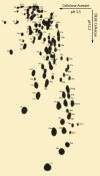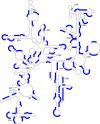The singular quest for a universal tree of life
- PMID: 24296570
- PMCID: PMC3973382
- DOI: 10.1128/MMBR.00038-13
The singular quest for a universal tree of life
Abstract
Carl Woese developed a unique research program, based on rRNA, for discerning bacterial relationships and constructing a universal tree of life. Woese's interest in the evolution of the genetic code led to him to investigate the deep roots of evolution, develop the concept of the progenote, and conceive of the Archaea. In so doing, he and his colleagues at the University of Illinois in Urbana revolutionized microbiology and brought the classification of microbes into an evolutionary framework. Woese also provided definitive evidence for the role of symbiosis in the evolution of the eukaryotic cell while underscoring the importance of lateral gene transfer in microbial evolution. Woese and colleagues' proposal of three fundamental domains of life was brought forward in direct conflict with the prokaryote-eukaryote dichotomy. Together with several colleagues and associates, he brought together diverse evidence to support the rRNA evidence for the fundamentally tripartite nature of life. This paper aims to provide insight into his accomplishments, how he achieved them, and his place in the history of biology.
Figures







References
-
- Crick FH. 1968. The origin of the genetic code. J. Mol. Biol. 38:367–379 - PubMed
-
- Watson J. 1965. Molecular biology of the gene. Benjamin Cummings, New York, NY
-
- Woese CR. 1967. The genetic code. Harper and Row, New York, NY
-
- Jacob F. 1974. The logic of living systems: a history of heredity. Translated from the French by Betty Spillmann. Allen Lane, London, United Kingdom
-
- Darwin C. 1964. On the origin of species. (Facsimile of 1859 edition.) Harvard University Press, Cambridge, MA
Publication types
MeSH terms
Substances
LinkOut - more resources
Full Text Sources
Other Literature Sources

